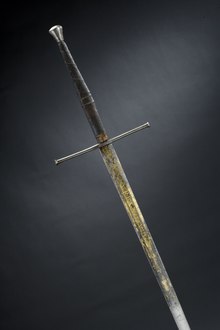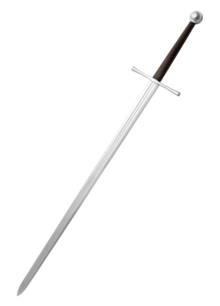Hilt[edit]
The hilt is the collective term for the parts allowing for the handling and control of the blade; these consist of the grip, the pommel, and a simple or elaborate guard, which in post-Viking Age swords could consist of only a crossguard (called a cruciform hilt or quillons). The pommel was originally designed as a stop to prevent the sword slipping from the hand. From around the 11th century onward it became a counterbalance to the blade, allowing a more fluid style of fighting.[dubious ][84] It can also be used as a blunt instrument at close range, and its weight affects the centre of percussion. In later times a sword knot or tassel was sometimes added. By the 17th century, with the growing use of firearms and the accompanying decline in the use of armour, many rapiers and dueling swords had developed elaborate basket hilts, which protect the palm of the wielder and rendered the gauntlet obsolete.[85]
In late medieval and Renaissance era European swords, a flap of leather called the chappe or rain guard was attached to a sword's crossguard at the base of the hilt to protect the mouth of the scabbard and prevent water from entering.[86]
Sword scabbards and suspension[edit]
Common accessories to the sword include the scabbard, as well as the 'sword belt'.
- The scabbard, also known as the sheath, is a protective cover often provided for the sword blade. Over the millennia, scabbards have been made of many materials, including leather, wood, and metals such as brass or steel. The metal fitting where the blade enters the leather or metal scabbard is called the throat, which is often part of a larger scabbard mount, or locket, that bears a carrying ring or stud to facilitate wearing the sword. The blade's point in leather scabbards is usually protected by a metal tip, or chape, which on both leather and metal scabbards is often given further protection from wear by an extension called a drag, or shoe.[87]
- A sword belt is a belt with an attachment for the sword's scabbard, used to carry it when not in use. It is usually fixed to the scabbard of the sword, providing a fast means of drawing the sword in battle. Examples of sword belts include the Balteus used by the Roman legionary.[88]
Typology[edit]
Sword typology is based on morphological criteria on one hand (blade shape (cross-section, taper, and length), shape and size of the hilt and pommel) and age and place of origin on the other (Bronze Age, Iron Age, European (medieval, early modern, modern), Asian).
The relatively comprehensive Oakeshott typology was created by historian and illustrator Ewart Oakeshott as a way to define and catalogue European swords of the medieval period based on physical form, including blade shape and hilt configuration. The typology also focuses on the smaller, and in some cases contemporary, single-handed swords such as the arming sword.[66]
Single and double-edged[edit]
As noted above, the terms longsword, broad sword, great sword, and Gaelic claymore are used relative to the era under consideration, and each term designates a particular type of sword.
Jian[edit]
In most Asian countries, a sword (jian 劍, geom (검), ken/tsurugi (剣), pedang) is a double-edged straight-bladed weapon, while a knife or saber (dāo 刀, do (도), to/katana (刀), pisau, golok) refers to a single-edged object.
Kirpan[edit]
In Sikh history, the sword is held in very high esteem. A single-edged sword is called a kirpan, and its double-edged counterpart a khanda or tega.[89]
Churika[edit]
The South Indian churika is a handheld double-edged sword traditionally used in the Malabar region of Kerala. It is also worshipped as the weapon of Vettakkorumakan, the hunter god in Hinduism.
Backsword and falchion[edit]
European terminology does give generic names for single-edged and double-edged blades but refers to specific types with the term 'sword' covering them all. For example, the backsword may be so called because it is single-edged but the falchion which is also single-edged is given its own specific name.[90]
Single vs two-handed use[edit]
Two-handed[edit]
Two-handed sword may be used to refer to any sword that usually requires two hands to wield. However, in its proper sense it should be used only to refer to the very large swords of the 16th century.[84]
Throughout history two-handed swords have generally been less common than their one-handed counterparts, one exception being their common use in Japan.
Hand and a half sword[edit]
A Hand and a half sword, colloquially known as a "bastard sword", was a sword with an extended grip and sometimes pommel so that it could be used with either one or two hands. Although these swords may not provide a full two-hand grip, they allowed its wielders to hold a shield or parrying dagger in their off hand, or to use it as a two-handed sword for a more powerful blow.[47] These should not be confused with a longsword, two-handed sword, or Zweihänder, which were always intended to be used with two hands.
In fiction[edit]
In fantasy, magic swords often appear, based on their use in myth and legend. The science fiction counterpart to these is known as an energy sword (sometimes also referred to as a "beam sword" or "laser sword"), a sword whose blade consists of, or is augmented by, concentrated energy. A well known example of this type of sword is the lightsaber, shown in the Star Wars franchise.







0 Comments